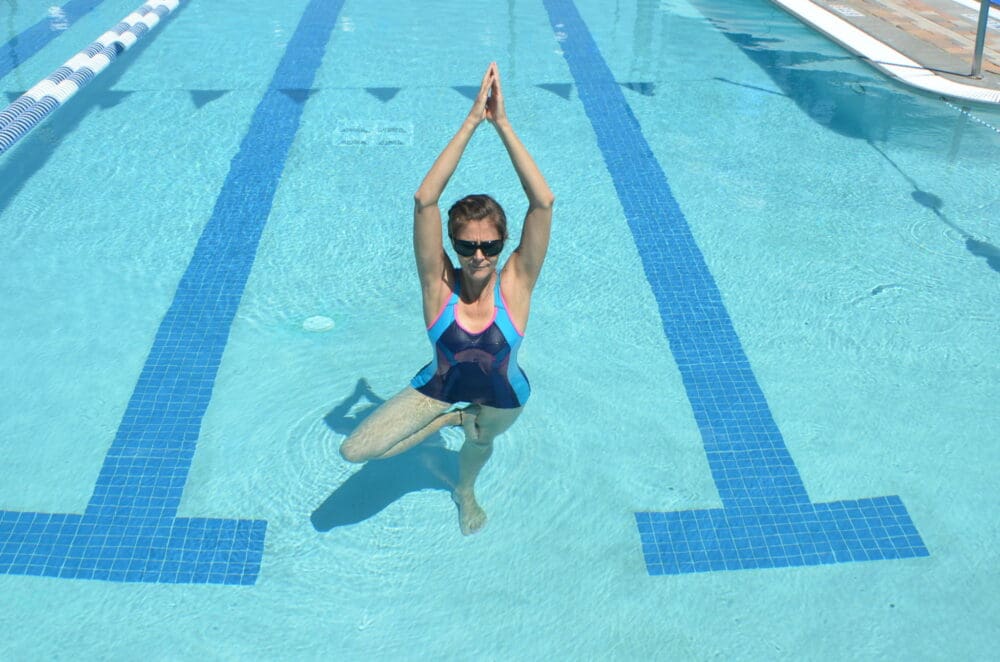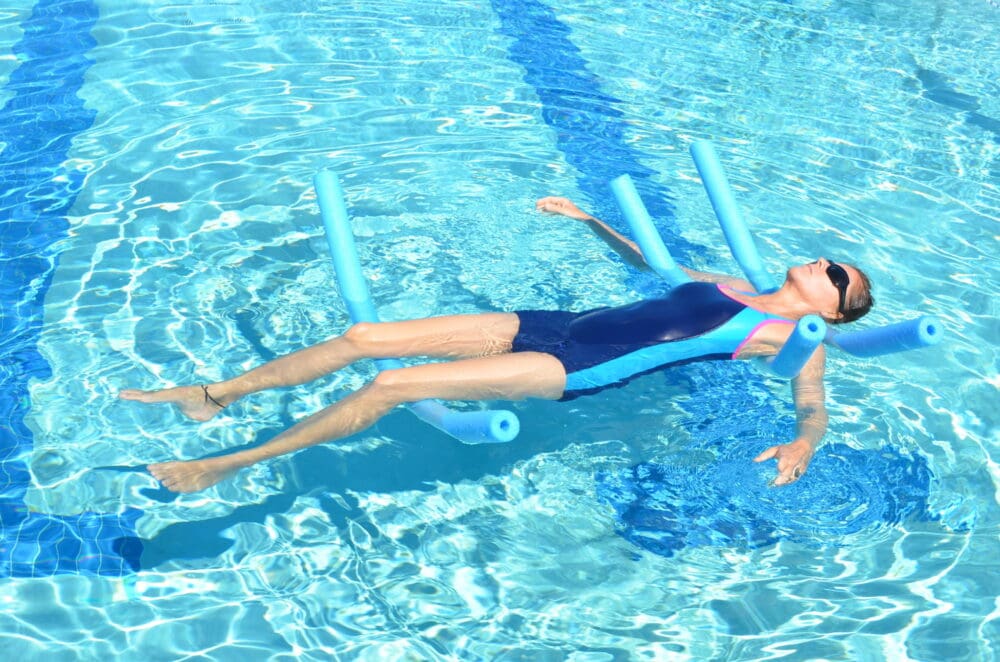If you’re a chronic pain patient like me, you’ve probably had someone, under the guise of being helpful, tell you to try yoga. But if you’re one of the millions of Americans with chronic pain — maybe because of a knee or joint replacement, arthritis in your hands or wrists, or other types of pain — yoga just might not be doable. However, there is a kind of yoga that can be especially helpful for chronic pain patients — aqua yoga for chronic pain.
When someone without chronic pain tells you to try yoga, it’s usually not helpful. Perhaps you used to practice yoga in the past and loved it. However, many of the more physical postures might not work for you anymore. Or maybe you’re just not willing to take the risk. Aqua yoga might be a good alternative to yoga on dry land and it’s as simple as it sounds. You do yoga in the shallow end of the lap pool. Knowing how to swim isn’t even important, because you practice standing yoga postures submerged to about mid-chest height.
The Benefits of Aqua Yoga for Chronic Pain
You might be wondering why aqua yoga is better than land-based yoga for chronic pain patients. Aqua yoga presents some unique opportunities because of the benefits of working in the water.
When you’re in the water, you feel the inward pressure of the water everywhere, like you’ve stepped inside a smooth sock. That’s called hydrostatic pressure. Practicing aqua yoga can reduce swelling, make your heart and kidneys work more efficiently, and reduce blood pressure.

Taking advantage of the buoyancy of the water is another benefit. When you’re standing at mid-chest height, you’ve offloaded about 70% of your weight with the buoyancy of the water. Having that load taken off of you can reduce pain in sore joints and increase your range of motion.
Submerging yourself in water provides resistance when you move in any direction. That means you get a very balanced muscular effort. You’re not stressing a joint by loading it really hard in one direction, but not at all in the other. Because of this resistance, you’re also burning more calories. But due to the buoyancy of the water, you actually perceive it as less effort.
How Aqua Yoga for Chronic Pain Helped Me
As a yoga teacher, my teaching has evolved to consist of primarily aqua yoga classes. The water is a great equalizer; it doesn’t matter if you have a spinal fusion, fibromyalgia, or amputated limb.
Anyone can participate in aqua yoga. I love the fact that I work with people who need walkers to get to the pool entrance, but once inside, can balance on one leg and do as many yoga postures as everyone else. When they stand on one leg with their arms overhead and a huge smile on their face, I feel like my work has paid off. And when they say, “I didn’t think I could do that anymore”, I feel so proud to have been the one to help them get there.
Healthy and hale people have many yoga choices. But the pickings get slim when you have health challenges. I know because I’ve done yoga longer than I’ve had my diagnoses. I used to enjoy a very vigorous physical practice that challenged my fitness level. However, as I got older and my health started to give me trouble, my yoga practice wasn’t working for me anymore.


Despite my love for yoga, my ego couldn’t accept that I needed to make changes to my practice. I also suffer from invisible illnesses — you can’t “see” either rheumatoid arthritis or lupus from the outside. Because of this, I wasn’t getting the support I needed from the yoga professionals I studied with.
My reason for practicing yoga still hinged on my wish for the yoga to look or feel a certain way, instead of my need to listen to my body. Every session, I’d ignore the joint crunching and resort to taking Advil afterward. That’s really not what yoga should be about and eventually, I radically changed my practice.
Nowadays, I practice yoga to feel better when I’m having a flare and as maintenance to keep myself flexible and limber, despite serious connective tissue destruction. Using my yogic breath allows me to calm my body and mind. I use my yoga meditation practice to keep my spirit resilient, despite the daily challenges of living with chronic illness.
The Bottom Line
Aqua yoga makes yoga a lot more accessible for me as a chronic pain patient. In the water, I can do postures that I’ve given up on land. The postures don’t hurt and I can have fun doing them. Furthermore, I get some of the physical benefits of those particular postures by keeping my cardiovascular system healthy and making yoga breathwork even more challenging than on land. On the other hand, a blissful float, with my eyes closed and ears underwater, makes my meditation practice that much more powerful.


Aqua yoga isn’t easy, don’t get me wrong. It requires good balance, keeps your brain super engaged and still provides a workout. But it works for me, the majority of chronic pain patients, and possibly for you as well.
When you bring your hands together at the end of a yoga class and say Namaste, one translation is: “the light in me salutes and honors the light in you”. Bringing my light out despite my chronic pain, and sharing it with others who find respite and solace in their practice, is what brings me back to the pool every day.
Do you have a story about chronic pain you’d like to share?
Are you on Facebook?
Join our online community by clicking here.





Working in water has been the best thing ever. I recovered 99.9% full range of motion in my shoulder after rotator cuff repair (once the doc released me from limitations). I’m obese so the water is the only place I can get full range of motion for any movement . I had not heard of water yoga so thank you for the informative article!